Coaching attacking play, and specifically, creativity in wide players, can be one of the most challenging concepts for coaches to improve in their players. However, it is often a piece of trickery or moment of magic in the wide areas that lead to the game’s defining moments. Every football fan can picture an occasion where a winger’s brilliance led to a goal. These game-changing impacts make taking the time to work on this tactical theory worthwhile.
The very best of the creative wide players have a combination of devastating speed, technical trickery and tactical understanding. This tactical analysis will analyse examples from various levels of the game to highlight some of the attacking tactical and technical concepts modern wide players require. This tactical theory will offer analysis and suggestions on how coaches can implement these tactics to improve and maximise their creative players.
Overlaps
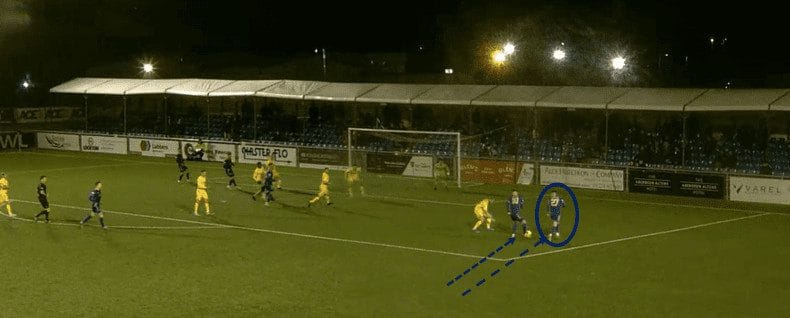
The relationship between full-backs and their wingers is a vital component of attacking in wide areas. A good understanding between these players can allow them the freedom, individually, to be creative and take chances when attacking. Overlaps are a major tactical element these players can use to devasting effect.
The above image is an example of a successful overlap, in the final third, from Cove Rangers against Greenock Morton in the SPFL. Cove’s winger received the ball, facing forward, and ran at the opposition full-back. When wingers receive the ball with their back to the goal, there must be space between the winger and the opposition full-back. This space must be large enough for the winger to have time to receive and turn to face forward. Otherwise, the winger will be turning into pressure and likely dispossessed without having the security of a full-back behind them.
When the winger receives or turns to be facing forward, the next action should be to drive at the nearest defender (full-back). This pins the full-back and provides the space for the overlapping player. As in the above example, the overlapping player should remain relatively close to the player on the ball. Instead of making a large, looping movement around his teammate, he made a tight, diagonal run. This minimised the amount of time the defender had to react and block the upcoming cross.
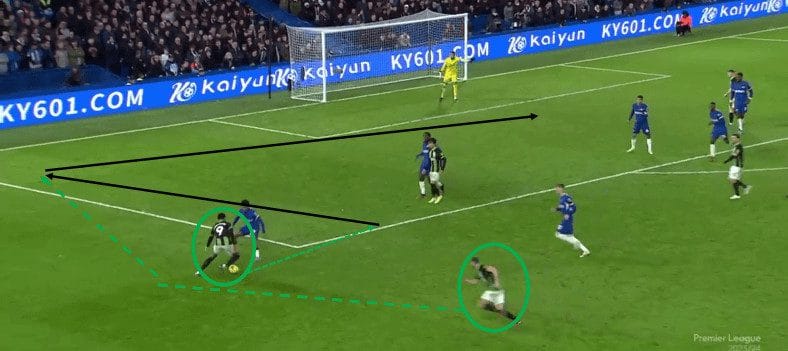
In this example, from Brighton’s Premier League match against Chelsea, Brighton’s winger receives under much tighter initial pressure. The wide forward’s inward-facing body shape and first touch inside the pitch act as the trigger for his full-back to overlap. Again, the full-back’s run is tight to his wide-forward.
In similar scenarios, this kind of overlap can also be used as a decoy for the wide-forward to shoot. When the opposition defender overcompensates to block the through ball into the full-back, this can create the space needed for a shot at goal.
Underlaps
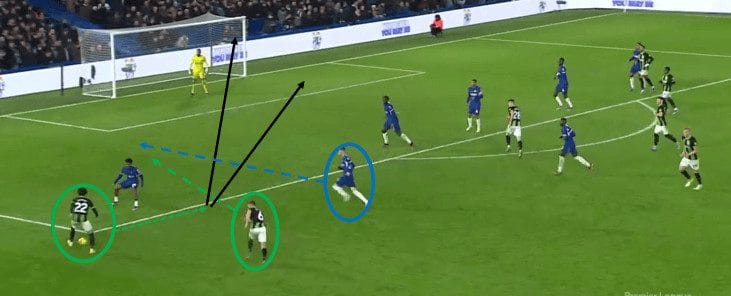
In this image from the same match, the wide forward receives in a similar situation as in the previous scenario. This time, #6 James Milner, occupying a full-back position, ran inside the wide forward. This action dragged away the central midfielder (circled), who was protecting the central area. Opening this central area allowed his forward to cut inside, giving him the opportunity to shoot at goal or cross the ball. Again, the wide-forward’s inward-facing body shape is essential as it provides many more options than if he were to be facing straight ahead.
Crossing from a standing position
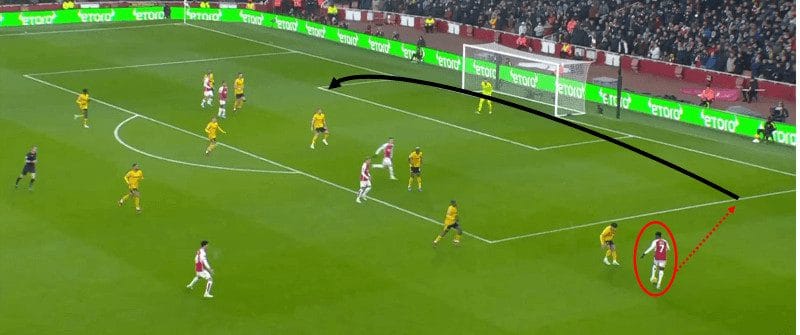
Although skill moves can be a great attribute for wide players to have, it is most often just the speed of their actions which creates opportunities. The above image is from the moments before Arsenal‘s second goal against Wolves. Bukayo Saka has just received the ball and is being closed down by Wolves’ wing-back.
Saka almost stops the ball, freezing his opponent before taking a big touch past the defender, accelerating onto the ball and providing a cross. Although this action is not as easy as a player like Saka makes it look, it shows there is not always the need to perform skill moves to beat an opponent.
Session plan
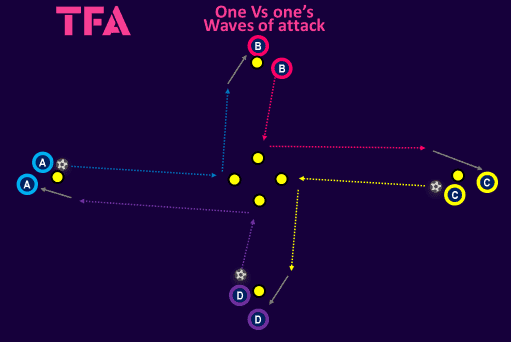
This exercise is designed to be implemented as part of the warm-up. The aim is to get players comfortable playing with the ball at their feet and to facilitate working on a variety of skill moves. The set-up and rotations are simple, with players divided equally amongst four cones with one ball at each cone. Working simultaneously, the players dribble towards the cones or mannequins in the middle. They turn left before dribbling to the next cone when they reach the middle. The next player in line then receives the ball and repeats the pattern.
Players can be given simple techniques such as cutting with the outside of their foot or faints to turn on the ball. Skill moves, such as scissors, stepovers, dragbacks etc. can then be introduced to add some complexity. Players, especially if working with younger age groups, should be encouraged to concentrate on their stance, close control and awareness when running with the ball. For older age groups and experienced players, the speed of their actions should be the focus. As well as introducing more complex dribbling movements, the exercise can be progressed by adding one-two’s between each set and changing the direction of the rotation.
Waves of attack – one on one’s
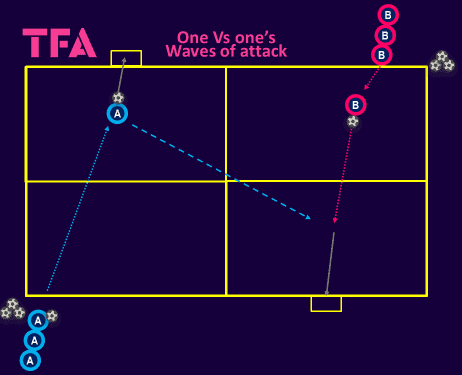
This continuous one-on-one drill focuses on players attacking with speed. Although skill moves are a valuable weapon to have, it is more often the speed of play that makes the difference. Wide players taking a directional first touch and being direct with the ball at their feet can be enough to take them beyond defenders. This means a skill move is not explicitly required most of the time.
For this exercise, the group is split into two teams, with each team defending one of the goals. The exercise begins with a player from one team attacking the goal directly opposite them. For the first play, the first player (shown as blue) dribbles with the ball unopposed and shoots at the small-sided goal. As soon as the ball is shot, the first player from the opposing team (pink) launches an attack. The blue player then becomes a recovering defender and tries to prevent the pink player from scoring. The attacking players must dribble across the halfway line before shooting. The pink shooter then becomes the recovering defender, and so on. If the defending player recovers the ball, they are given the opportunity to attack again.
The exercise repeats until a certain number of goals are scored or for a pre-determined amount of time. Coaches should emphasise the speed of play, encouraging players not to hesitate when attacking the goal. To force attacking players to play quickly, after shooting, players should be reminded to transition quickly to defence.
Waves of attack – 2v2
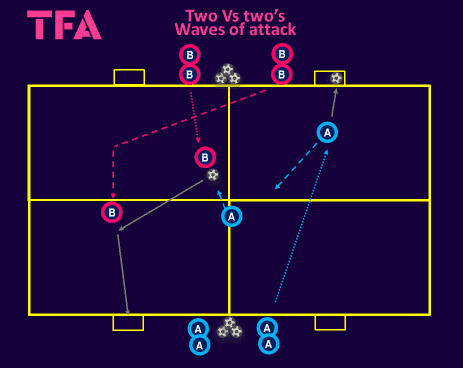
As a progression from the one-on-one exercise, using the same area, two more goals are added, with the game becoming a two-on-two with waves of attack. The play begins with one team (shown as blue) attacking either of the two goals opposite them. As with the first exercise, players cannot shoot until they are in the opposition’s half. As soon as the shot has been taken, the attacking (blue) team transitions to become the defending team. The first two players from the opposition (pink), with a new ball, quickly launch an attack with the aim of scoring before the blues can recover.
At the beginning of the exercise, the drill can be adapted so that only the player who shoots becomes the active defender (two-on-one). Once players have found the rhythm of the exercise, both players from the attacking team become active defenders (two-on-two). The attacking team should be encouraged to leave the non-shooting player in a central area (shown on the diagram). This allows that player to be positioned to slow the opposition’s attack down whilst the shooter recovers. It also allows the attacking team to work on pinning defenders, making for a more realistic, game-like scenario.
As well as the speed of play, this drill is designed to help develop the relationship between full-backs and wingers when attacking together. Concepts, such as the overlap, can be introduced, and players should be encouraged to start recognising triggers in their teammates’ play. For example, should the in-possession player’s first touch be inside, towards the opposition’s central player, that is a trigger for the teammate to overlap him.
To progress the exercise, a target player, representing a striker, can be introduced between the small-sided goals they are attacking for each team. This gives the attacking team a moving target, which they must play off before shooting at goal.
Crossing and finishing exercise
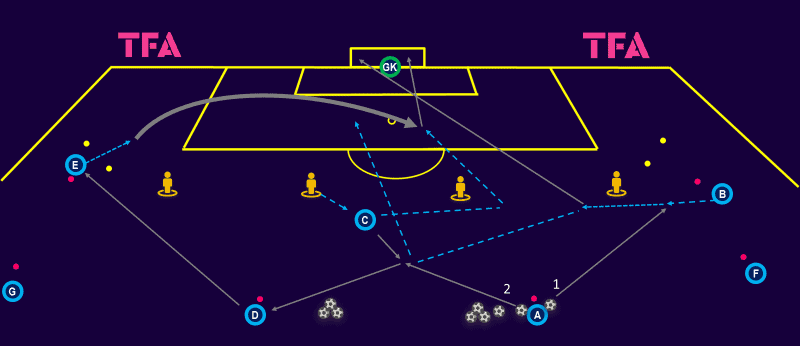
This crossing and finishing exercise allows wide players to work on their final product by delivering various types of crosses and taking shots at the goal. Each round consists of three shots at goal, with the players working continuously until the set is complete.
The above image shows the first two rotations. The ball starts centrally with player ‘A’ passing wide to player ‘B’, representing a wide forward. The pass is played short of ‘B’, forcing the forward to move inside to receive it. ‘B’ receives with an inward-facing body shape and continues moving inside with the ball before releasing a shot at goal.
The second play begins with the striker, ‘C’, showing to receive from player ‘A’, who plays a firm pass into the striker. The striker takes the weight out of the pass and lays it into the path of ‘B’, who has continued his run after shooting. ‘B’ plays to ‘D’, who switches the ball out wide to the left-forward. The left-forward takes a diagonal touch between the yellow gates and provides an early cross.
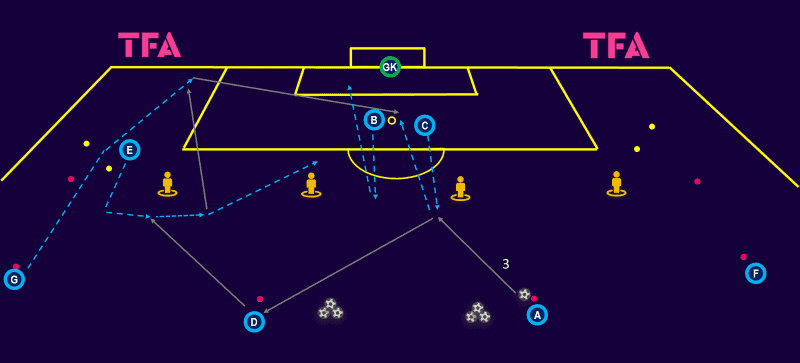
The third shot arrives after an overlap that leads to a cutback. The ball again starts with player ‘A’, who passes into ‘C’, who is moving to an “onside” position. ‘C’ plays a bounce pass to ‘D’, who aims a pass to the inside of player ‘E’. Player’ E’, the left-forward, takes a touch inside whilst G, the full-back, overlaps. The ball is fed into ‘G’ deep by the outside of the box. The full-back then delivers a cutback.
After the three shots at the goal have been taken, the players reset before repeating the exercise out the opposite side. How the players rotate between sets is at the discretion of the coach. It may be the preference to keep players in their usual playing positions.
In addition to focusing on the wide players, the players attacking the box should be coached in movements that give the wide players a realistic target to hit. The exercise can be progressed to add in shadow or full opposition players.
Small-sided wide zone game
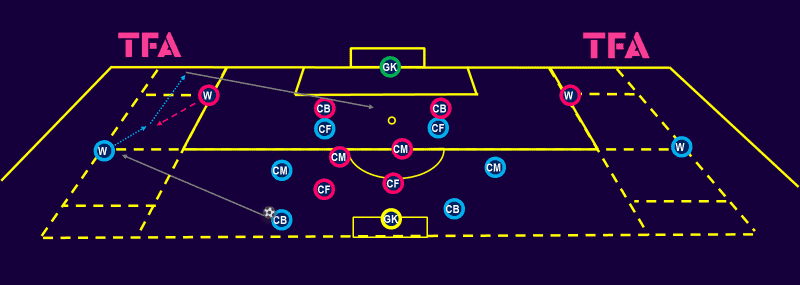
This small-sided 8v8+GK zone game is designed to isolate the wide players in one-on-one situations where they are forced to take on their direct opponent. The wide players, shown as “W” in the image above, must remain in the wide areas, with their six outfield teammates staying in the central area.
Each wide zone has an end zone six yards from the touchline. The attacking team’s aim is to play into their wide player, who must take on his direct opponent and cross from the end zone for a goal to be scored. The defending winger is positioned on the edge of the endzone and can press as soon as the ball enters the wide area.
When the ball is played into the winger, the attacker has two choices: take on the “full-back” or pass back into the middle. To encourage speed of play and fast, good decision-making, if the ball is passed back into the middle, it has to be done with the winger’s first touch. Often, pressing teams will overload wide areas and suffocate teams. This one-touch rule prevents the attacking team from becoming trapped on one side and allows for switches of play.
11v11
The zone game can then be expanded to a full 11v11 on a shortened (half or 3/4) pitch. The size of the field can be shortened so that the wide players are constantly receiving in advanced positions. This maximises their attacking involvement and provides the opportunity for lots of attacking repetitions. Involving the whole team allows the coach to work on phases of play that create opportunities for their wide players to attack.
A condition for scoring, such as the ball must be played into the wide area before a goal can be scored, can be added. Alternatively, a goal originating from these areas could count double. These rules help to manufacture attacking phases of play that involve the wide players.
In the 11v11, the same points of emphasis to the wide players should be expressed throughout the rest of the session. Importantly, they should be reminded to either attack quickly down their side of the pitch or play early back into the middle to allow a switch of play.
Conclusion
Traditionally, white players have been some of the most exciting players on the pitch. Fans love to see their wingers take players on and deliver crosses into the box. Players like Cristiano Ronaldo, Thierry Henry, and, in present times, Saka have always been fans’ favourites due to the excitement their flare brings.
To develop and get the most out of these players, they should be given a structure within practices and games that allows them to express themselves. Mistakes and turnovers of possession are inevitable with creative wide players; however, in tight games, it will most likely be these players who can make the difference.






Comments